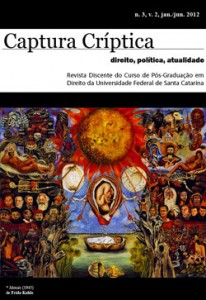Community justice in the Sierra Tarahumara: axiological and epistemological construction
Keywords:
Raramuri indigenous world, Conflict resolution, Normative multiplicity, Communality, Reciprocity, Normative systemsAbstract
The Raramuri indigenous people of Mexico have their own forms of conflict resolution. These forms are part of its normative system and therefore of the multiplicity of norms in the same socio-political space. In these alternative ways of resolving conflicts, different legal principles are manifested, such as the principle of reciprocity and communality, which have as their source the indigenous Raramuri worldview in their intersubjective relations with nature, in which the balance with the macrocommunity and the stability of the community, become a mission, without the need to monitor and punish as does the official law.
References
ARTAUD Antonin. México y viaje al país de los tarahumaras. México Fondo de Cultura Económica, 1992.
CORREAS, Oscar. Introducción a la sociología jurídica. México, Fontamara, 2007 Correas _____Derecho Indígena Mexicano I, México, Coyoacán, 2007.
COLLIER, Jane, “Justicia Popular en Zinacantan”. America indígena. XXL, México, III-INI, 1982.
HUBER Rudolf, y otros (coodinadores). Hacia sistemas jurídicos plurales. Colombia, Konrad Adenauer Stiftung, 2008.
FALK Moore, Sally.”Certanties undone: fifty turbulent years of legal anthropology, 1949-199” The journal of the Royal Anthropological institute, s. p. i., 2001,
FIERRO, Luis Alfonso, “Tarahumaras solo comen pinole”. El Universal. Diario, 28 de noviembre de 2011.
FOUCAULT, Michel. La verdad y las formas jurídicas. 2° edición, México, México, 2008.
FOUCAULT, Michel. Vigilar y castigar. 35 edición, México, siglo XXl 2008. LAGUNA Cerda, Horacio “Costumbre Jurídica” México Indígena. México, año IV, 2a época, núm.25, Nov.-Dic. 1998.
LUMHOLTZ Carl. El México Desconocido. traducido por Balbino Dávalos, Nueva York editorial Nueva York Charles Sribner’s Sons, 1904 Tomo I otra Editora nacional, México 1970.
NICOLAU Coll, A y Vachon, R. “Etnicidad y derecho: un enfoque diatópico y dialogal del estudio y enseñanza del pluralismo jurídico”, Etnicidad y derecho. Un dialogo postergado entre los científicos sociales, Serie Cuadernos del instituto, México, Instituto de Investigaciones Jurídicas-UNAM, 1996.
MONTEMAYOR Carlos. Los tarahumaras, pueblo de estrellas y barrancas. 2° edición, México, ALDUS 1999.
OLIVÉ León. Multiculturalismo y pluralismo. Paidos, México, 2007.
ORDÓÑEZ Cifuentes, José Emilio. R. Derecho Indígena en Mesoamérica. México 2007.
OROZCO Hidalgo, María Elena. Tarahumara una antigua sociedad futura. Chihuahua México, Secretaria de Desarrollo Comercial y turístico, Instituto Chihuahuense de la Cultura, 2006.
OST, Francois y Michel Van de Kerchove. Elementos para una teoría critica del Derecho. Colombia, Universidad de Colombia, 2001.
SOUSA, Santos, Boaventura De. Critica de la razón indolente, Contra el desprecio de la experiencia. Bilbao, Descée, 2003.
SARIEGO Rodríguez, Juan Luis. El indigenismo en la Tarahumara. México, Instituto Nacional Indigenista y consejo Nacional para la cultura y las Artes, 2002.
SÁNCHEZ Botero, Esther.” Construcciones epistemológicas para el análisis de sistemas de derecho propio y de las justicias indígenas”. Doxa. Número 25, 2002.
TEUBNER, Gunther. “El Derecho como sujeto epistémico: hacia una epistemología constructivista del derecho”. Doxa. Número 25, 2002.
TIGAR Michael y Levy R. Madeleine. El Derecho y el acenso del Capitalismo. México, Siglo Veintiuno, 1983.
VELASCO RIVERO, Pedro J. Danzar o morir. México, ITESO, 2006. WOLKMER, Antonio Carlos. Pluralismo jurídico de una nueva cultura del
Derecho, Sevilla, MAD S. L., 2006.
Downloads
Published
How to Cite
Issue
Section
License

This work is licensed under a Creative Commons Attribution-NonCommercial-NoDerivatives 4.0 International License.
Submissions published in the Captura Críptica Journal are under the Creative Commons Attribution-noncommercial-NoDerivatives 4.0 International License.










